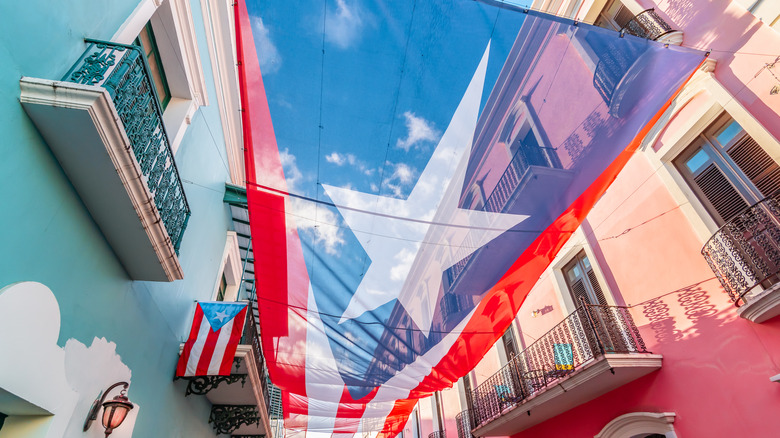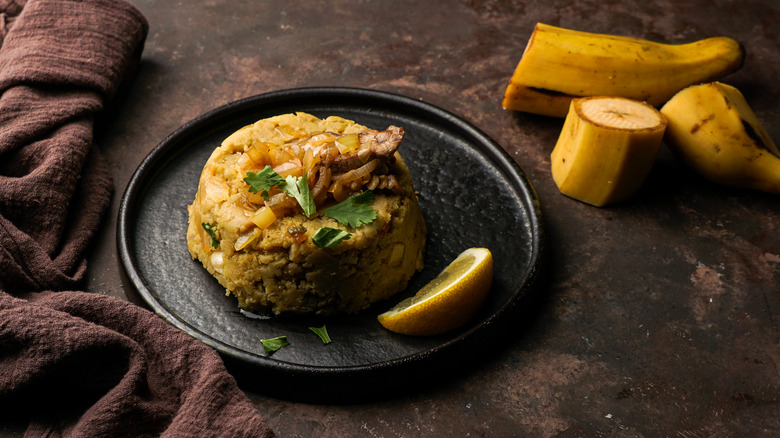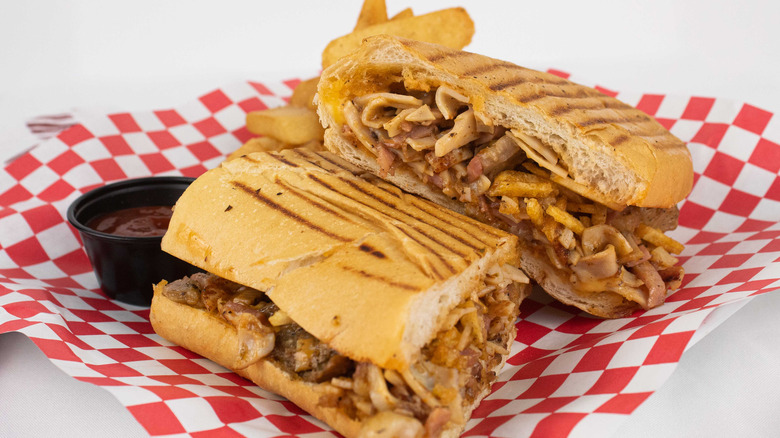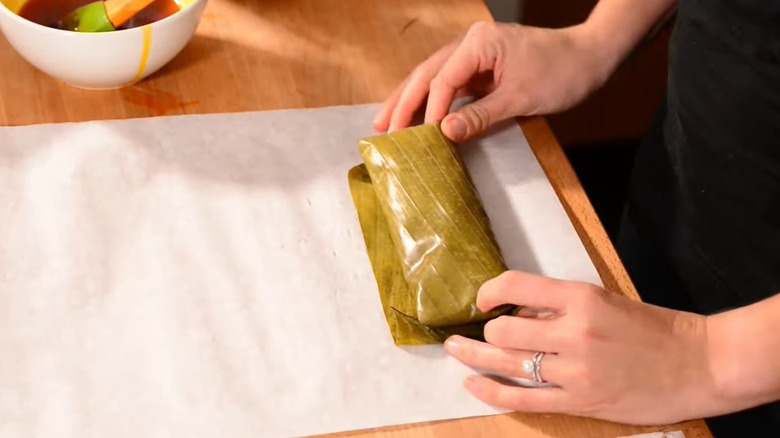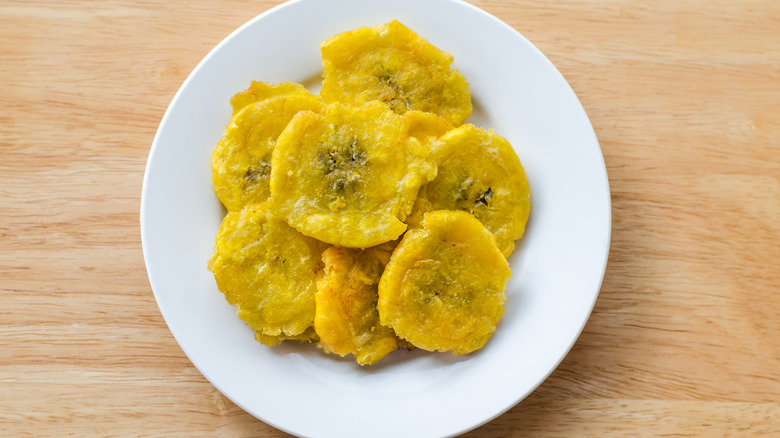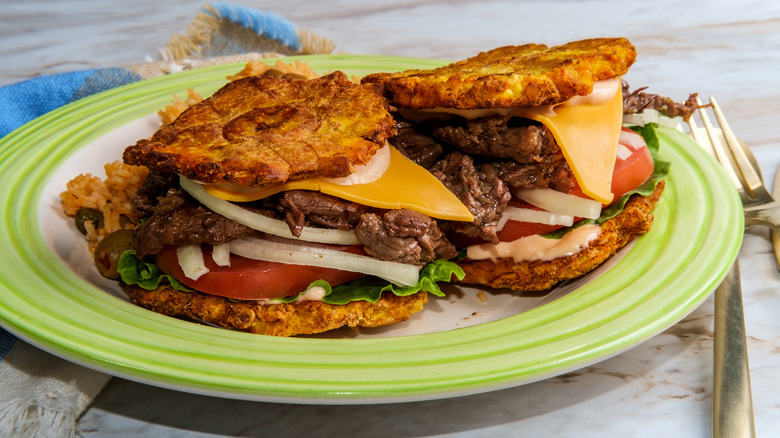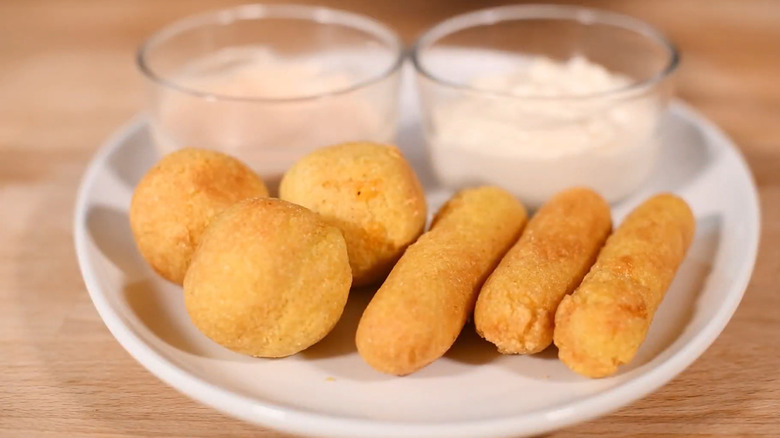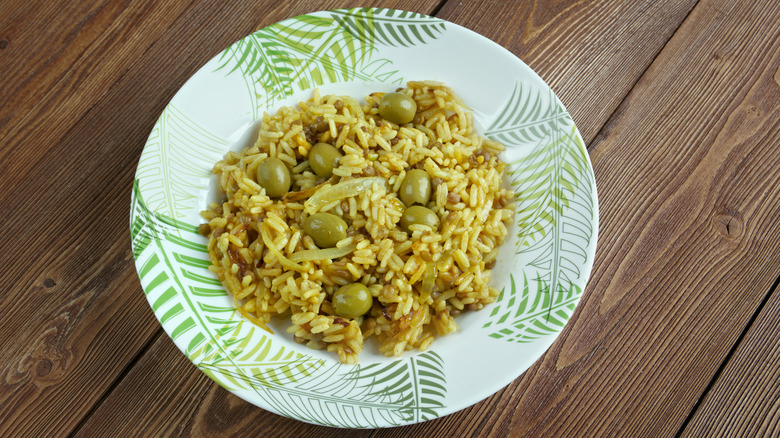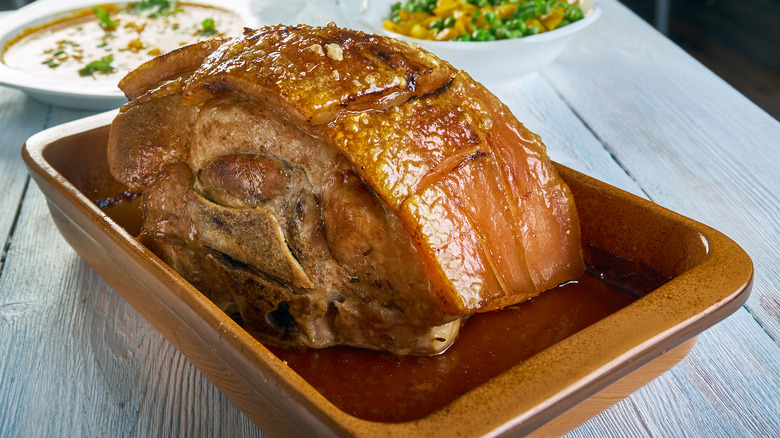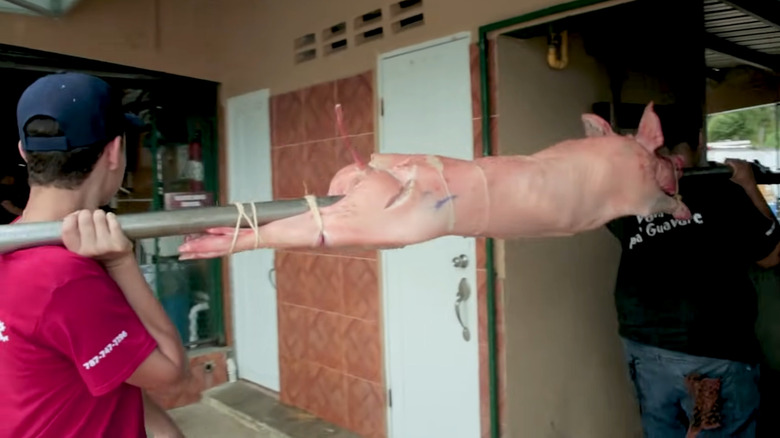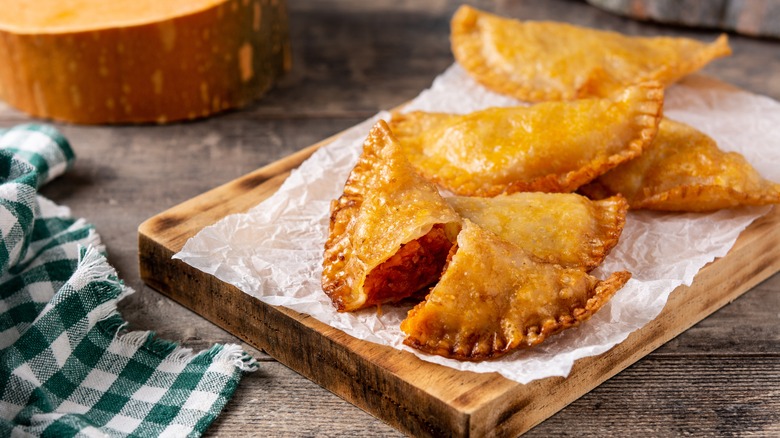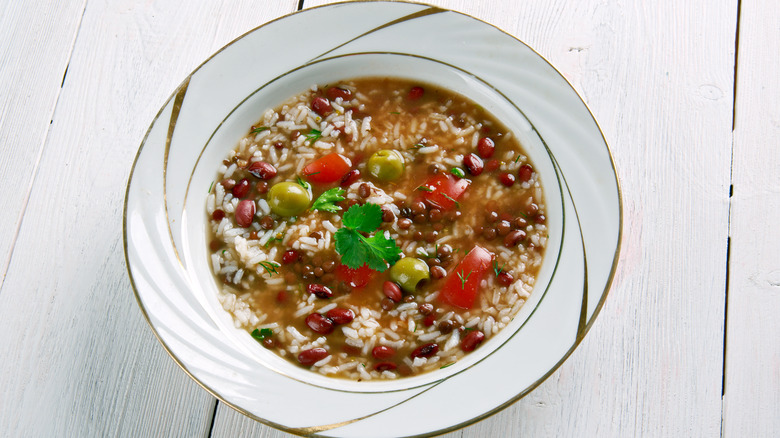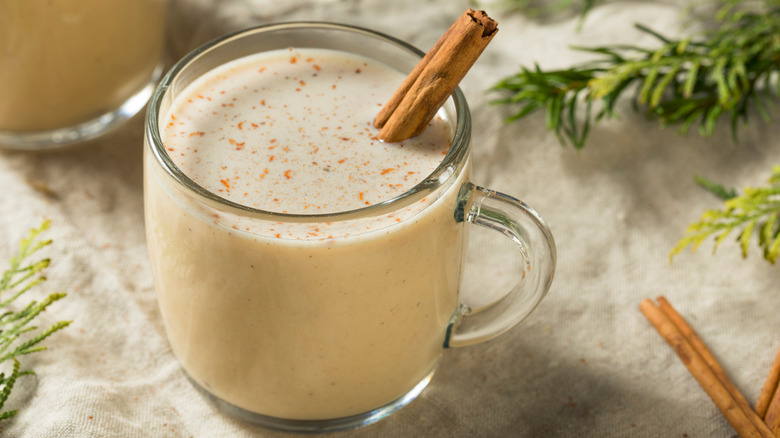The Puerto Rican Dishes You Absolutely Need To Try
As reported by History, Puerto Rico is an archipelago that has been deeply influenced by a number of cultures. Hunter-gatherers first inhabited the island alongside the Arawak Indians. The Taino, a subgroup of the Arawak, became the dominant population of Puerto Rico pre-Columbus, with a population ranging between 20,000 and 50,000 by the late 1500s, per Britannica.
The arrival of the Spanish and their subsequent colonization of the archipelago changed Puerto Rican society and culture forever. Furthermore, a reliance on an enslaved, largely African, workforce during this time also brought new cultural practices to the island. More changes were experienced in the late 19th and early 20th centuries when America gained control of Puerto Rico. According to Britannica, the main goal of American governors at the time was Americanizing Puerto Rico, both culturally and structurally — a process that has indelibly influenced the lives of all Puerto Ricans to this day.
A country's food reflects its cultural identity, and Puerto Rico is no different with contemporary ingredients, cooking techniques, and dishes all speaking to the archipelago's complex socio-cultural history. Many of its dishes offer not only a wide array of flavors and textures, but also a bite-sized look at Puerto Rico's history. If that's not reason enough to enjoy some amazing food, we don't know what is.
Mofongo
Perhaps no food better exemplifies the expression of Puerto Rico's multifaceted culture than mofongo. It's Puerto Rico's unofficial national dish, but what exactly is mofongo? made from fried, pounded green plantains, which are then formed into a dough before being shaped and stuffed with vegetables and meat, according to The Washington Post. Mofongo's likeness to fufu, a dish popular in both West and Central African countries, is uncanny. Both employ cooking and pounding to soften starchy vegetables, and both are stuffed with a variety of meat and vegetables (via Britannica).
However, to say that mofongo is solely the product of African influence would be inaccurate. As reported by BBC, the tool used to mash the plantain — which is called a pilón — comes from Puerto Rico's Taino population. Furthermore, the garlic, onion, and herb mix used to flavor mofongo — known as sofrito — originated in Spain. This highlights the fact that all of Puerto Rico's disparate populations have contributed to the creation of mofongo.
This mix of global ingredients and cooking methods is combined to make something both delicious and uniquely Puerto Rican. This sentiment is shared by Puerto Rican chef Raúl Correa, who affirms that mofongo represents the archipelago's people and plays an important role in Puerto Rican culture (via Smithsonian Magazine). This makes mofongo a dish that every person should try at least once in their lives.
Tripleta
BBC reports that pigs were introduced to Puerto Rico during Columbus' second voyage to the Americas in the late 15th century. Pork has since become one of the most widely-adored foods in Puerto Rico, serving as the centerpiece for many important celebrations such as New Year's Eve and Noche Buena (per The Wall Street Journal).
However, pork is not only consumed during feasts and celebrations. Rather, it is commonly enjoyed as part of the archipelago's daily rhythms, frequently in the form of tripleta. Name because of the trio of meats used to fill it, tripleta is a sandwich considered worker's fare thanks to its robust filling of steak, pernil, and ham, per The Washington Post. According to Taste Atlas, the sandwich also boasts robust toppings, which include cheese, Puerto Rico's ubiquitous mayo-ketchup, and french fries.
Tripleta is a perfect example of how pork is consumed on a daily basis in Puerto Rico, offering a different perspective on the cuisine while also highlighting the meat's importance to the archipelago's food culture. Tucking into a tripleta sandwich is a must for anyone looking to experience the full range of Puerto Rican cuisine.
Pasteles
From pork, we move on to another food product incredibly important to Puerto Rican cuisine: plantain. Despite growing extremely well in Puerto Rico, plantains are not actually native to the archipelago. In fact, they were only brought to the Caribbean in the early 16th century, according to Whetstone Magazine.
While there are numerous Puerto Rican dishes that celebrate plantains, not many are met with as much affection as pasteles. These steamed parcels are made with a mixture of mashed green bananas, plantains, and other starchy vegetables. This mixture is then stuffed and traditionally with meat before being wrapped in a plantain leaf and boiled, per The New York Times. This plantain-heavy mixture can be tweaked through the addition of any number of vegetables, as demonstrated by chef Derick López of the highly popular Freakin Rican in New York, who creates his with taro root and kabocha squash (via The New York Times).
Pasteles are very similar to tamales, per Immaculate Bites, but take on a unique significance in Puerto Rican culture, especially around Christmas and other holidays. Their quintessentially Puerto Rican taste and gummy texture make them a favorite of nearly everyone who tries them.
Tostones
Tostones are the other extremely popular Puerto Rican dish made from plantains. These pressed, twice-fried golden discs are a common sight throughout both Puerto Rico and the United States. This is partly because of the ease with which they can be made, as well as the wide availability of the ingredients: green plantains, oil, water, and salt. Consequently, tostones are an accessible way for many Puerto Ricans to enjoy and reconnect with their culture, wherever they may be in the world (per Whetstone Magazine).
According to The Plantain Council, the fruit's neutral flavor, cooking versatility, and quick growth in tropical climates have made it the 10th most important staple food in the world. Since its introduction to Puerto Rico, plantains have been used to sustain its various populations. Whetstone Magazine reports that enslaved workers were forced to consume the crop, as were poor farmers who often relied on plantains to survive times of scarcity. It's not difficult to see why dishes like tostones have become etched into the Puerto Rican identity.
Today, tostones are not only a common feature in Puerto Rican households, but also in Puerto Rican restaurants. Whether it's in high-speed Bronx-based trailer restaurant, La Piraña Lechonera (via The New York Times), or Puerto Rico's highly esteemed Bacoa (per BBC), tostones will be available. Or if you're looking for a slightly healthier version at home, tostones can be baked as well.
Jibarito
We have established the Puerto Rican affinity for both plantain and meat-based sandwiches. But what happens when you combine the two? Well, you get something called the jibarito. This sandwich — which is filled with steak, mayonnaise, lettuce, and tomato — has a very Puerto Rican twist. Instead of bread, the sandwich is bordered by two pieces of fried plantain. The jibarito has become wildly popular since it was created in Chicago by Juan C. Figueroa, chef and owner of the now-closed Borinquen Restaurant. Figueroa was inspired to make the jibarito after reading about a similar sandwich being made in Puerto Rico itself, per the Chicago Tribune.
Since it was established in the late 1990s and early 2000s, the jibarito has become a massive hit in the United States, and is now known as an iconic Chicagoan dish. Many restaurants around the city continue to serve it, giving people the opportunity to taste this unique blend of Puerto Rican and Midwest culture. These include Jibaritos y Más, a small, family-owned chain found around the city. Owner Jesus Arrieta makes what Chicago Tribune has called the best jibarito Chicago has seen in decades. The secret? Make it fresh and to order, ensuring the sandwich maintains its iconic crisp texture, per Eater Chicago.
Sorullos
Sorullos are cigar-shaped, fried corn flour sticks that are frequently filled with cheese (per Taste Atlas). Simple to make, sorullos are usually served as a side dish or snack and are eaten hot. While their crisp exterior and fluffy, cheesy interior make them instantly appealing to most, sorullos have also become widely popular throughout Puerto Rico thanks to their association with chinchorros.
According to Smithsonian Magazine, chinchorros are the Puerto Rican food stalls that stand together in streets throughout the archipelago. Local custom is to eat, walk, and dance from one to another trying dishes as you go. Sorullos frequently feature in these settings, served alongside other classics of the cuisine, such as arroz con gandules. Their grab-and-go nature makes them perfect for the informal nature of chinchorros, which Puerto Rican culinary tour guide Stephen Santiago compared to Texas roadhouses, per Smithsonian Magazine.
Sorullos are also so widely loved in Puerto Rico because they serve as the perfect vehicle for one of the archipelago's favorite condiments, mayo-ketchup. Known to some as fry sauce, mayo-ketchup has been popular in Latino communities for decades, and frequently tops fried foods such as sorullos and tostones, according to The Washington Post. That means you can enjoy two iconic Puerto Rican foods in just one mouthful.
Arroz con Gandules
Arroz con gandules holds a special place in most Puerto Rican hearts. The dish — which is made with sofrito, pigeon peas, rice, and pork — is frequently labeled as one of the archipelago's national dishes, as reported by Taste Atlas. It is often eaten alongside other Puerto Rican favorites, including lechón (per Smithsonian Magazine) and even jibaritos (via Chicago Tribune).
Despite the near-universal love for arroz con gandules across Puerto Rican populations, when it is eaten and how it is perceived varies greatly from the United States to Puerto Rico itself. A study published in Food and Foodways highlighted that Puerto Ricans on the archipelago deem arroz con gandules as a special dish, saved for consumption on special occasions, such as Christmas. In contrast, Puerto Ricans in New York City viewed the dish as more of a staple, one to be consumed consistently throughout the year.
Either way, the dish is special. Not only because of the distinct, warming flavor of nutty pigeon peas (per Food Print), but because of the diverse cultures it represents. Chef
Reina Gascón-López says arroz con gandules is among her favorite Puerto Rican dishes to share with people because of its cultural amalgamation, per The New York Times.
Pernil
Roasted pork, in any form, is well-loved in Puerto Rico. But pernil might be the most popular of all. Made with roasted pork shoulder, pernil can be found in homes and restaurants throughout Puerto Rico and the United States. The meat is known for its succulent, tender, and shreddable texture and is a favorite at Puerto Rican Christmases, as per Forbes.
The meat achieves its brilliant taste thanks to marinating overnight in two iconic flavorings, sofrito and adobo. Sofrito, usually made with culantro — a stronger variant of cilantro that grows widely on the archipelago, according to The New York Times – adds a herbaceous flavor to the pork. On the other hand, adobo — a wet marinade that contains vinegar — provides a much-needed tang that cuts through the rich meat (via Taste Atlas). Forbes reports that small incisions are usually made on the meat and both the sofrito and adobo are usually stuffed in.
As perhaps Puerto Rico's most famous dish, and a much more flavorful alternative to your regular ham joint, pernil is a brilliant way to experience the classically Puerto Rican tastes of pork, sofrito, and adobo. And since it's just the shoulder, pernil is a classic Puerto Rican pig dish that can be made in a home kitchen — a stark contrast to the space and equipment needed to make lechón asado.
Lechón Asado
If Puerto Rican culture is known for impulsive, intoxicating parties, then lechón asado is known as the food that fuels them. Per The New York Times, where there's a party in Puerto Rico, there is invariably a roasting pig. Nowhere is this more true than on Road 184, in Puerto Rico's town of Cayey, which is better known by its nickname, la Ruta de Lechón, or "pork highway" (via Atlas Obscura).
Traditional lechón asado is prepared by roasting a whole pig on a spit over a bed of charcoal for eight hours (per Atlas Obscura). However, many lechoneras on pork highway now use gas stoves, according to The New York Times. Regardless of what heat source is used, the cooked lechón is carved up with a machete, with all of the finished cuts being mixed together to create a steaming heap of tender meat. These are then topped with a shard of crisp pig skin.
While often made on celebrations such as Christmas, lechón is also served as the ultimate party food. Every weekend raucous parties are held on pork highway, with dancing, drinking, and a plethora of lechón asado. So, if Puerto Rican fun is what you are looking for, follow your nose to restaurants selling delicious lechón — the party won't be far away.
Empanadillas
Empanadas are a dish that, in one form or another, span the globe. They consist of fried pastry that is used to envelop a filling. Of course, these fillings vary widely, but Puerto Rican ones usually revolve around ground beef or other meats (via Democrat & Chronicle).
Times Union reports that empanadas came from Arabic sfeehas. These hand-held meals will have been common throughout Spain during the Middle Ages thanks to the period of Muslim rule over what is modern-day Spain and Portugal from 711-1492 (via BBC). As Times Union states, Muslim and Arabic influence on Spain during this time resulted in the creation of traditional Arabic dishes with an Iberian twist, of which empanadas were one. Spain's colonization of the Caribbean and South, Central, and North America led to empanadas being introduced throughout what we now call Latin America.
In Puerto Rico, empanadas have taken the form of empanadillas, sometimes known as pastelillos. Empanadillas are generally smaller than Spanish empanadas and are frequently eaten as snacks for both children and adults alike, per Democrat & Chronicle. Consequently, empanadillas provide an easy, low-commitment way to experience Puerto Rican cuisine, one that can be easily tailored to your own specific preferences.
Asopao
Asopao is one of those dishes that seems to embrace you as you eat it. The warming part-stew, part-soup dish is a favorite throughout Puerto Rico and features sofrito, rice, olives, and tomatoes, as well as a protein (per The New York Times).
Raymond Sokolov's book "Why We Eat What We Eat" highlights that asopao is popular throughout the Caribbean, including the Dominican Republic. There, the dish is served with crisp, fried chicken skin. Chicken also features in the most popular type of Puerto Rican asopao — asopao de pollo (via Taste Atlas).
Asopao de pollo is not only the most popular asopao in Puerto Rico, but also the most traditional. Still, chef Mario Pagán, insists that there is no one way to make aspao, nor a single overarching classic recipe, per The Takeout. It all comes down to taste and preference. Though it's popular during holidays and celebrations, especially in the winter, it can be enjoyed anytime by anyone.
Coquito
Coquito is the quintessential Christmas-time beverage, enjoyed by Puerto Ricans throughout the festive period. Made with a can of evaporated milk, sweetened condensed milk, cream of coconut, and coconut milk, sweetness and coconut definitely dominate the flavor profile, according to The Washington Post. However, the inclusion of a number of spices and a glug of rum adds to the coquito picture. Roberto Villanueva, a Puerto Rican who produces and sells coquito, told Sarasota Sarasota Magazine that drinkers should look for cinnamon and nutmeg as typical spices, but might find recipes that use vodka or sherry, and even some that contain egg yolks.
While each family may have its own spin on coquito, the drink's significance remains the same. The drink is made for sharing, most classically during parrandas — festive Puerto Rican events that involve singing, eating, and drinking, as per New York Latin Culture Magazine. So, if you want to experience a taste of a Puerto Rican Christmas, there is no better way to start than by making and sharing a few glasses of ice-cold coquito.
